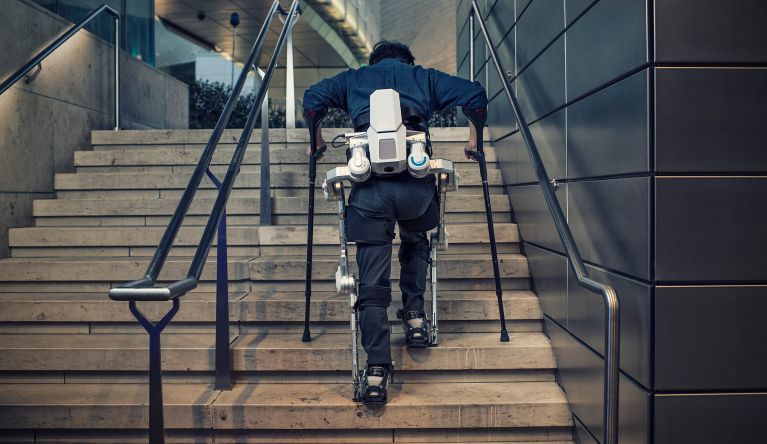- Innovations in assistive technologies allow Hyundai Motor to deliver mobility solutions beyond the automobile
- Hyundai Motor’s wearable powered robots can provide independent personal mobility for paraplegics and the elderly
- Robotic developments include a wearable exoskeleton to assist with heavy lifting in the workplace
Press material
-
Download
-
Images
Hyundai Motor has revealed new wearable powered robots that will revolutionize the future of personal mobility.
The latest innovations in advanced assistive medical, work and daily life exoskeletons are on show at the 2017 Consumer Electronics Show (CES) in Las Vegas, demonstrating Hyundai Motor’s ambition to provide customers with personal mobility solutions and freedom beyond the automobile.
The H-MEX (Hyundai Medical EXoskeleton) helps patients with lower spinal cord injuries regain the ability to walk. By utilizing a wireless clutch with on-board motion control system, the equipment gives paraplegics the ability to sit, stand, move, turn and even walk up or down stairs.
The H-MEX (Hyundai Medical EXoskeleton) helps patients with lower spinal cord injuries regain the ability to walk. By utilizing a wireless clutch with on-board motion control system, the equipment gives paraplegics the ability to sit, stand, move, turn and even walk up or down stairs.
The HUMA (Hyundai Universal Medical Assist) exoskeleton operates on a different control principle, but it provides assisted mobility support for people with limited muscular power. It provides assistive torque to help those with limited mobility to easily move their bodies. By adjusting assistive torque according to each form of movement, such as walking, running, or going up and down stairs, HUMA assists users to move effortlessly. It can support up to 40kg of a wearer’s weight and, unloaded, can run at a speed up to 12km/h – capabilities that would benefit for military/industrial purposes such as load-carrying. Meanwhile, the Hyundai Waist EXoskeleton, known as H-WEX, provides upper-body and hip support to prevent back injuries for workers doing repetitive manual work or lifting heavy objects.

We have a vision that Hyundai Motor will become more than just a manufacturer of cars and the advances we make in assistive robotic technologies will allow us to offer customers new levels of mobility freedom. In the future, we hope our pioneering exoskeleton devices will enrich the daily lives of users and form the basis for us to provide more mobility platforms for the well-being of our customers.
H-MEX and HUMA are powered by removable and rechargeable battery packs and their light-weight frames are adjustable in length to fit different sizes of user for ultimate comfort. The lower back and knees are supported with harness fixture points, while the devices change shape and flexes around the artificial joint structures of the robotic frame to manage body posture and deliver gait efficiency for walking.
In this vein, H-MEX provides individually-tailored gait pattern adjustment by calculating a series of factors, including walking pace, length of stride, and torso tilting angle via an application program installed in a smart device. Moreover, HUMA uses a series of advanced joints and mechanisms to align its movement with that of the user, enabling agile motion.
In this vein, H-MEX provides individually-tailored gait pattern adjustment by calculating a series of factors, including walking pace, length of stride, and torso tilting angle via an application program installed in a smart device. Moreover, HUMA uses a series of advanced joints and mechanisms to align its movement with that of the user, enabling agile motion.

The H-WEX takes similar form but instead provides a safety solution for the workplace, assisting users with heavy lifting and other strenuous or repetitive activities. Activating the Waist Assist function enables the exoskeleton to flex its joints at up to 180 degrees per second, with an operating algorithm built-in to ensure ultimate user safety. As with the other exoskeletons, the frame of the device supports and protects the user’s lower back and upper legs for optimal body positioning and is light-weight to ensure portability and ease of use.













